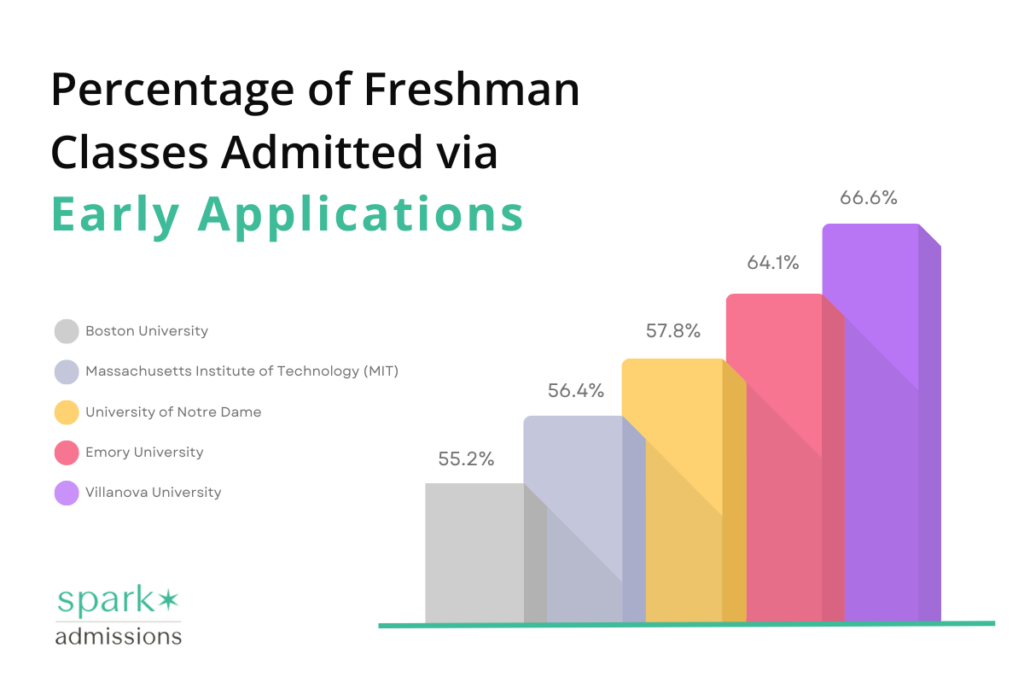- Blog
- > Early Decision
Does Applying Early Action or Early Decision Increase Your Chances of Acceptance? The Data Says Yes!
- Dr. Rachel Rubin
- | November 29, 2024

Navigating the competitive landscape of college admissions can feel overwhelming. Students are constantly looking for ways to maximize their chances of acceptance at their dream schools. Wondering “Does Early Decision (ED) increase your chances?” and comparing it to the question “Does Early Action (EA) increase your chances?” is natural.
While strong academics and extracurriculars are essential, one strategy consistently stands out: early decision. Does applying early decision truly increase your odds of receiving that coveted acceptance letter?
The data suggests a resounding yes.
Understanding Early Decision and Its Impact
The college admissions process is filled with nuanced strategies and options, each impacting your chances of acceptance differently. Among these, early decision and early action stand out as potentially the most impactful choices for students who are certain about their top-choice college.
However, understanding the implications of the early application round is crucial before diving in.
ED isn’t simply about submitting your application earlier; it’s about making a commitment to your future. This commitment, while advantageous, requires careful consideration and self-reflection.

Defining Early Decision and How It Differs from Early Action
Early decision and early action are often mistakenly used interchangeably. However, we must emphasize the difference. Both involve applying to college earlier than the regular decision deadline, but their implications vary significantly.
Early Decision is Binding
Early decision is a binding agreement between you and the college. If accepted under early decision, you are obligated to withdraw applications from other schools and attend that institution.
Early decision can be further categorized into Early Decision I (ED I) and Early Decision II (ED II). This distinction allows students to apply to their preferred colleges with different deadlines. Early Decision I typically has an earlier deadline, usually November 1st, and students who apply during this period will receive their admissions decisions mid-December. On the other hand, Early Decision II deadlines are usually in January, providing students with more time to finalize their applications, and decisions are usually received mid-February. Both ED I and ED II offer applicants the opportunity to demonstrate their strong interest in a particular institution by committing to enroll if accepted. Colleges greatly value this binding commitment since it results in a 100% yield for admitted early decision students.
Early Action is Not Binding
Early action, while also offering an earlier application timeline, is non-binding. EA applicants are free to decline an accepted offer and consider other colleges. This application type provides more flexibility and control over your college decision. It is worth noting that the percentage of schools offering early action options has steadily increased over the years, with approximately 450+ colleges now offering this application choice.
On the other hand, choosing this option may reduce your acceptance chances compared to an early decision application, as universities, especially private universities, may prioritize early decision applicants over early action applicants. As for public universities, they often favor in-state students when considering EA applicants, so out-of-state students may not get as much of a boost from applying EA as other applicants would. Nevertheless, applying early action still increases acceptance chances over applying regular decision.
To complicate matters further, some colleges and universities offer Restrictive Early Action (REA), a slightly different non-binding early application option. Unlike Early Decision, REA allows students to apply early to a school without being committed to attending if accepted; however, unlike Early Action, REA places limits on the other schools to which a student can simultaneously apply. This can be a great choice for students who have identified a top-choice school but still want to compare financial aid offers from other institutions.
By applying early through REA, students can demonstrate their strong interest and potentially receive an admission decision earlier in the process. Additionally, applying REA may result in slightly higher chances of acceptance. It’s important for applicants to carefully review each school’s specific policies regarding REA to understand any restrictions or requirements associated with this application option.
Understanding the difference between early decision and early action is crucial for making informed decisions aligned with your individual preferences and risk tolerance.
Can You Apply to Multiple Colleges Under Early Decision?
No, applying early decision restricts you to applying to a single college during the early decision period. The binding agreement means you’re committed to attending that specific institution if accepted. However, some colleges offer Early Decision II deadlines, allowing you to apply for an early decision at another college if you are rejected from your first choice. If there are two schools where you have an interest in applying early decision and one of them has an ED II round, this gives you will have two chances to receive the benefit of applying early decision.
Statistical Overview: Early Decision Acceptance Rates Across Top Colleges
The proof is in the data. Examining the difference between regular decision and early decision acceptance rates at various top schools paints a compelling picture. Across the board, colleges tend to admit a significantly higher percentage of early decision applicants compared to the overall applicant pool.
Let’s look at a few examples compared to the overall regular decision rate:
| University | Early Decision Rate (Class of 2028) | Regular Decision Acceptance Rate |
| Northwestern University | 23% | 6% |
| Columbia University | 12% | 3% |
| Tulane University | 68% | 3% |
| Dartmouth College | 17% | 4% |
| Emory University | 32% | 9% |
| University of Miami | 60% | 6% |
To get a clearer picture of how applying early action or early decision impacts your chances of admission, we researched the percentage of incoming freshman populations that were accepted early action or early decision. Based on our research, the average number of students in a freshman class who were admitted ED or EA is a resounding 50.39%, with some colleges as high as 66%!

| University | Percentage of Freshman Class Accepted Under Early Decision, Early Action, and Restrictive Early Action |
| Barnard College | 59.90% |
| Bates College | 65.10% |
| Boston College | 55.20% |
| Boston University | 55.70% |
| Bowdoin College | 52.60% |
| Brown University | 50.20% |
| Carleton College | 42.2.% |
| Carnegie Mellon University | 33.10% |
| Case Western Reserve University | 37.80% |
| Cornell University | 45.80% |
| Dartmouth College | 49.60% |
| Davidson College | 65.70% |
| Emory University | 64.10% |
| George Washington University | 27.40% |
| Georgetown University | 46.30% |
| Hamilton College | 51.90% |
| Harvard University | 41.20% |
| Harvey Mudd College | 40.20% |
| Lehigh University | 51.70% |
| Massachusetts Institute of Technology (MIT) | 56.40% |
| Middlebury College | 65.70% |
| Northwestern University | 54.70% |
| Princeton University | 39.50% |
| Rice University | 41.80% |
| Santa Clara University | 64.4.% |
| Smith College | 45.60% |
| University of Notre Dame | 57.80% |
| University of Pennsylvania | 49.20% |
| University of Rochester | 39.90% |
| University of Southern California | 31.90% |
| Vanderbilt University | 51.70% |
| Vassar College | 47% |
| Villanova University | 66.60% |
| Washington and Lee University | 56.40% |
| Washington University in St. Louis | 60.90% |
| Wellesley College | 48% |
| Wesleyan University | 57.20% |
So, what does this mean for you?
While these numbers don’t guarantee admission for every early applicant, they highlight a clear trend: applying early significantly improves your odds, often doubling or even tripling them compared to applying regular decision, and the most competitive universities in the country are prioritizing early applicants.
Conversely, this also means that it is incredibly difficult to get into these schools during the regular decision round. At that point, there are very few spots left in the freshman class, as so many have already been taken by early decision applicants.

Analyzing the Benefits of Applying Early Decision
The higher acceptance rates for early decision applicants are not arbitrary. Instead, they reflect the advantages early decision offers both students and colleges. For students, it’s about securing a spot at their top-choice institution. For colleges, it’s about crafting a predictable and committed incoming class.
This alignment of incentives is at the heart of why early decision has become such a popular and impactful strategy in the college admissions world. Let’s examine these benefits in greater detail.
How Early Decision Affects Your College Admissions Opportunities
Early decision offers a significant boost to your college admissions prospects. The data consistently shows that early decision applicants enjoy higher chances of acceptance compared to equally qualified regular decision applicants. This difference boils down to a few key factors.
Firstly, early decision demonstrates a strong commitment to the college. Admissions committees see this as a positive signal, as it essentially guarantees enrollment in the freshman class if they are admitted. In a competitive admissions landscape, such certainty is invaluable.
Secondly, the early decision pool often consists of highly motivated students who have thoroughly researched their top-choice college. This translates to stronger applications with well-articulated interests and a genuine desire to contribute to the campus community.
The Strategic Advantage of Demonstrating Commitment to Your First-Choice School
Beyond the statistical advantage, early decision allows you to send a powerful message to your dream school: you’re all in. This unwavering commitment, which is unavailable in regular decision applications, can provide a significant admissions advantage.
When you apply early decision, you’re not just expressing interest – you’re making a statement.
You’re telling the college that they are your top choice, and you’re willing to forego other options for the opportunity to attend. This level of commitment is attractive to colleges, as it simplifies their enrollment planning and reduces uncertainty. It allows them to allocate resources more effectively and build a class with a strong sense of community.
In a sense, early decision is a win-win situation. It increases your chances of acceptance while providing colleges with a valuable commodity: committed students eager to contribute to their campus.
Can You Apply to Multiple Colleges Under Early Decision?
No, applying early decision restricts you to applying to a single college during the early decision period. The binding agreement means you’re committed to attending that specific institution if accepted. However, some colleges offer Early Decision II deadlines, allowing you to apply for an early decision at another college if you are rejected from your first choice. If there are two schools where you have an interest in applying early decision and one of them has an ED II round, this gives you will have two chances to receive the benefit of applying early decision.
What Happens If You Get Rejected from Early Decision?
While early decision can significantly improve your chances of acceptance, rejection is still a significant possibility. If this happens, don’t despair—it’s not the end of your college application journey! Many factors influence admissions decisions, and an early decision rejection doesn’t inherently necessarily reflect your qualifications or potential as a student.
The admissions process is designed to find the right fit for both students and colleges. If you’re rejected from your early decision school, you can still apply to other colleges through regular decision applications. Use this as an opportunity to reassess your college list and explore other options that might be a better fit academically, socially, or financially.
Remember, receiving multiple college acceptances is fantastic, but ultimately, finding the right school for you is the goal. Don’t be afraid to pivot, reassess, and continue exploring your options.
Is Early Decision Right for Everyone?
While the benefits of early decision are undeniable, it’s essential to acknowledge that it’s not the right choice for everyone. The college application process is deeply personal, and no single strategy fits all situations. Early decision, with its binding nature, requires a level of certainty about your top-choice college that some students might not have at the application stage.
Before diving into the early decision pool, ask yourself some crucial questions: Can your family afford the estimated cost of attendance without comparing financial aid packages? Are you comfortable with the possibility of no longer having the option to attend other colleges if you are accepted early decision?
If you’re unsure about any of these factors, options like early action or regular decision might be a better fit. Remember, the goal is to find the approach that best aligns with your needs and maximizes your chances of success.
Spark Admissions has the highest college admissions success rate in the country
Schedule A Free Consultation with an Admissions Expert
Schedule NowDecoding the Admission Process: Insights from A College Admissions Expert
As college admissions consultants, we invest a lot of time into understanding the strategy behind admissions and acceptance rates.
To truly understand the impact of early decision, gaining insights from those on the other side of the admissions desk is invaluable. Admissions officers often cite several reasons why colleges favor early decision applicants, and those motivations shed light on the strategic thinking behind enrollment management.
By understanding how admissions officers evaluate applications, we gain a more nuanced perspective as to why certain strategies, like early decision, prove more advantageous than others.
Let’s peer into the minds of admissions professionals and uncover the rationale behind their decisions.
Why Colleges Favor Early Decision Applicants
Admissions committees are tasked with building a diverse and talented incoming class while also ensuring a high yield rate – the percentage of accepted students who enroll. Early decision applicants provide a level of predictability that contributes to a more stable yield. As such, it’s no surprise that colleges often have a higher acceptance rate for early decision applications.
When you apply early decision, it signals a strong commitment to the institution. Admissions officers know that if they accept an early decision applicant, that student is highly likely to enroll. This certainty is invaluable in their enrollment management strategy.
ED applicants tend to be well-prepared and highly motivated, often showcasing a deep understanding of the college’s values and programs. This genuine interest shines through in their applications, further solidifying their desirability as potential students.
The Role of Early Decision in College Enrollment Management Strategies
Colleges invest significant resources in crafting enrollment management strategies aimed at shaping their incoming class. Early decision, as we’ve explored, plays a pivotal role in these efforts. By leveraging early decision, colleges can more accurately predict college enrollment numbers, optimize resource allocation, and build a cohesive community of students.
ED allows colleges to “lock in” a portion of their incoming class earlier in the cycle, reducing uncertainty and allowing for more strategic planning. These benefits are particularly crucial for smaller, more selective institutions with lower acceptance rates overall.
Additionally, colleges can focus their resources on attracting specific student populations during the regular decision round by filling a portion of their class with committed early decision students. This strategic use of early decision contributes to a more diverse and well-rounded student body.
Financial Considerations and Financial Aid Implications
While the prospect of an increased acceptance rate is enticing, understanding the financial implications of early decision is absolutely vital. Unlike regular decision, early decision limits your ability to compare financial aid packages from different colleges. Since your admissions decision is binding, you won’t have the leverage of competing offers when negotiating financial aid and scholarships.
Before submitting your early decision application, carefully evaluate your family’s financial situation and the estimated cost of attendance. Use the college’s net price calculator to get a sense of potential out-of-pocket expenses. If affordability is a concern, waiting for the regular decision deadline might be a better strategy. This approach will allow you to compare financial aid offers and choose the most financially viable option.
Remember, college is a significant investment, and finding the right financial fit is crucial for long-term success. Don’t let the allure of higher acceptance rates overshadow the importance of affordability and responsible financial planning.
So, Does Applying Early Decision Increase Your Chances of Acceptance?
The data is clear: early action and early decision applications boost college acceptance rates. Understanding the commitment and strategic benefits these application types offer can, therefore greatly impact your admissions odds. However, with early decision in particular, you should also weigh the binding nature and the financial considerations before making this choice.
Ultimately, while early decision isn’t for everyone, its impact on college enrollment strategies and student outcomes cannot be overlooked, but you still have to make an informed decision that considers all aspects of your college experience.


